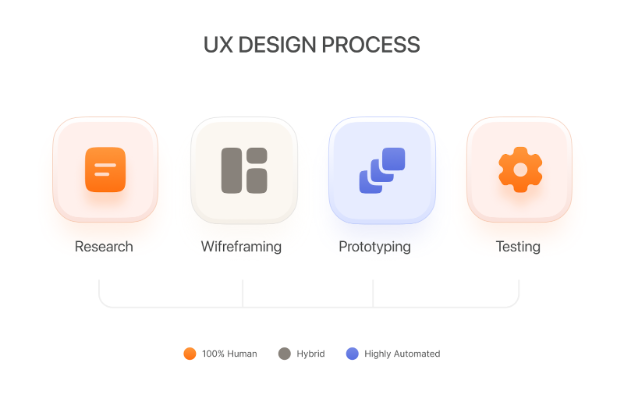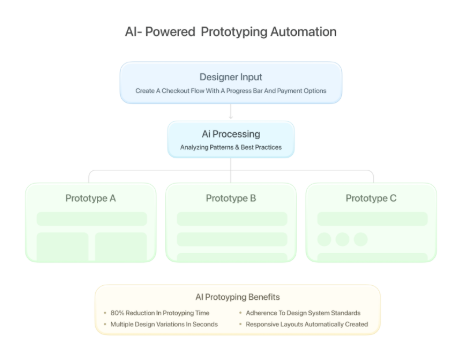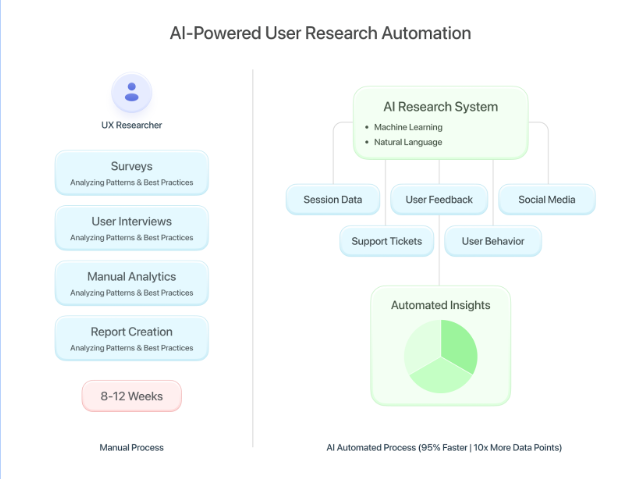The ‘Generative AI’ wave has disrupted industries at breakneck speed in recent years – including the UI/UX design space. Since 2020, AI adoption among designers has surged from just 15% to a projected 75% in 2025, fundamentally changing how we design digital experiences.
Design tools now generate wireframes in seconds, analyze user feedback with 70-90% better efficiency, and prototype interfaces in less than half the time previously required.
With such rapid evolution, there’s one question that often keeps popping up in conversations with fellow designers and clients: “Will UX design be automated?”
The short answer is – no. While AI accelerates repetitive tasks, it cannot yet replace human judgement, creativity or empathy – paving the way for forward thinking teams, such as the one at my agency – Bricx to pair AI with human input and create faster, smarter and more thoughtful design processes.
This article will explore what’s possible with AI in UX, what will remain human and how product folks can ready themselves for the inevitable.
So let’s dive right in.
Current State of UX Automation – What’s the Scenario?
The likes of Figma & Sketch have already started adding elements of artificial intelligence into their processes & workflows.
These features help designers automate specific tasks which would otherwise take hours to execute, including:
- Generating basic design components
- Adapting layouts, and,
- Automating repetitive tasks.
The likes of ChatGPT, Claude & Midjourney are also being used to create content & generate design ideas.
That being said, a majority of UX professionals have indicated that while automation has streamlined parts of their process, AI is far off from replacing their jobs entirely.
Research supports it too, with a recent survey by Adobe revealing:
About 70% UX designers believe that automation tools save them time on repetitive tasks, allowing better focus towards more creative aspects.
It’s clear: While advancements in AI have helped save time & improve productivity, they still require human oversight to ensure the final product meets the user’s needs.
For the time being, these tools won’t replace the need for human creativity & thinking – they’ll rather enhance it.
What Tasks Can Be Automated with AI in UX Design?

Several repetitive tasks under UI/UX design can be efficiently automated using AI, freeing designers to focus on more strategic output.
Some of these include:
- Design automation and prototyping: Automated prototyping tools enable designers to update components across multiple screens simultaneously, ensuring consistency while reducing manual effort.
This acceleration is particularly valuable for projects requiring frequent iterations.

- Feedback aggregation and analysis: Instead of manually sifting through emails, messages, and documents, design feedback tools such as ProofHub can consolidate feedback from various sources into centralized dashboards. This organization helps teams prioritize critical design adjustments more efficiently.
- Data-driven design decisions: Automation can connect directly to analytics platforms, providing real-time user behavior insights. This integration ensures design decisions are backed by empirical evidence rather than assumptions.
- Accessibility testing: Automated tools can efficiently check designs against accessibility standards like WCAG. This verification identifies issues such as poor color contrast or missing alt text, ensuring inclusive design without time-consuming manual reviews.
What UX Automation Won’t Do? – A Closer Look
Imagine an AI tool generating a dashboard prototype for a SaaS product: it produces a clean layout with default charts, buttons, and navigation. Functionally, it’s fine, and the team saves hours.
But when the dashboard needs insight prioritization, highlighting the most critical metrics, or microcopy that guides users with empathy, AI falls short.
This is where human involvement comes in – with the designer helping improve visual hierarchy, tweaking labels for clarity and ensuring the dashboard reduces cognitive load; all of which directly influences usability & conversions.
Given that, here are the key aspects of UX design that AI won’t be able to replace (as of now):
- Understanding emotional context and user motivations
AI tools can analyze click patterns, scroll behavior, or engagement metrics, but they cannot fully interpret the emotional context behind user actions.
For example, a drop-off in a signup flow could mean confusion, frustration, or simply a user being distracted, but AI can only detect the “what,” not the “why.”
According to the Nielsen Norman Group, emotional design directly influences user satisfaction, trust, and retention.
Human designers can empathize with users, identify pain points, and design experiences that resonate emotionally – something AI still struggles to replicate.

2.Solving complex multi-step UX problems
Designing multi-step flows, like onboarding a SaaS platform or configuring a complex dashboard, requires contextual thinking and decision-making across multiple touchpoints.
AI may generate functional layouts, but it often lacks the ability to evaluate the end-to-end user journey, anticipate friction points, or prioritize tasks based on user goals.
As per David Truog, VP & Principal Analyst at Forrester Research – AI currently excels at supporting discrete tasks, but human designers will remain essential to holistic problem-solving and strategic UX decisions.
3.Maintaining brand tone and human-centered empathy
While AI can replicate color schemes or layouts, it cannot understand a brand’s “voice” or nuanced user sentiment.
Subtlety in UX, like microcopy phrasing or emotion-driven UI decisions, require empathy for the target audience, alongside cultural sensitivity and alignment with business values.
These aspects are also crucial in establishing a brand’s personality & trustworthiness, and hence, require different levels of human involvement to make things work better.
To sum it up, while AI is crucial for efficiency, speed and consistency, elements like intuition, emotional intelligence & context-aware decision making are uniquely human capabilities.
Designers who understand these boundaries can leverage AI where it helps most, while still retaining control over the strategic and empathetic aspects of UX.
Skills Designers Will Need in an AI-Assisted UX World
As AI becomes a core part of UX workflows, designers aren’t just expected to “use the tools” — they’ll also need strategic, interpretive, and adaptive skills that allow them to collaborate effectively with AI while keeping designs human-centered.
- Critical thinking & interpretation: AI can generate wireframes, layout suggestions, and even usability reports, but it cannot decide which insights align with your users’ emotions or business goals.
Designers will need to inculcate the ability to analyze, question, and contextualize AI outputs to ensure decisions are meaningful. - Data literacy: With AI generating vast amounts of insights, designers will need to understand how to read, interpret, and synthesize data, spotting patterns and anomalies that influence user flows.
Skills in usability metrics, heatmaps, and engagement analytics will further become essential. - Hybrid prototyping & rapid iteration: Iterating new designs and creating prototypes is often the most cumbersome part of any UX design process.
By learning to work with tools like Fray and Uizard, designers will be able to explore multiple visual directions and variations, leveraging AI to experiment faster & then using their own judgement to guide the final design. - Human-centered decision making: Empathy remains irreplaceable. Designers must translate AI-generated patterns into experiences that resonate with users, balancing efficiency with emotional impact.
- Collaboration & communication: AI may handle repetitive or exploratory tasks, but designers must communicate findings, guide stakeholders, and make decisions that align UX with business strategy.
Strong storytelling and team collaboration skills remain critical.
By developing these skills, designers can leverage AI as an augmentation tool rather than a replacement, allowing teams to scale without losing creativity, empathy, or strategic insight.
How to Structure Your Design Team for an AI-first Future?
Now, while designers will need to upskill themselves for AI, it’s crucial for decision-makers to also make decisions that actually bring in the best of both human skill and the evolving technology landscape.
The real question, especially for decision makers then, wouldn’t be: “What can AI help me do?”, but rather around how they can organize their design team and processes around effectively leveraging AI in their workflow.
Here’s some actionable tips to help you structure your UX team for an AI-first future:
- Redefine roles around outcomes, not outputs: Instead of assigning tasks like “create wireframes” or “analyze user tests,” define outcomes such as “improve onboarding success rate” or “reduce friction in checkout.”
While AI can accelerate outputs, humans interpret the meaning behind the results.
- Adopt hybrid workflows: Some steps, such as data collection, usability pattern recognition and report generation – can be automated. Alternatively, critical decisions such as journey mapping and emotional UX considerations will remain human-led.
Structuring your workflow around this hybrid model will keep your team efficient without sacrificing creativity. - Create AI review loops: Encourage designers to review, refine, and challenge AI outputs. This builds a culture where AI is an intelligent assistant, not a crutch, ensuring insights translate into actionable, user-centered design decisions.
- Prioritize high-impact tasks for humans: Let AI handle repetitive, data-heavy, or exploratory work so humans can focus on problem-solving, storytelling, and strategic UX choices that directly affect business goals.
In practice, teams that structure their workflows around human-AI collaboration will see faster iterations, better insight synthesis, and more time for creativity and innovation, without losing the empathy-driven essence of UX design.
Conclusion
Looking ahead, UX teams that embrace AI intelligently will thrive. Product leaders will need to structure teams and create workflows that combine both human creativity and AI efficiency, building true resilience against the rapidly evolving technological landscape.
A smart approach could also involve partnering with design studios or agencies that understand AI-first workflows – teams that will act as an extended arm, supporting internal UX teams with both human expertise and AI-augmented capabilities.
Author bio:
Siddharth is the CEO at Bricx, where he leads the design function for the company. With nearly a decade in design and SaaS, he has worked with various B2B startups to help them grow using high-conversion websites & product design. You can connect with him on LinkedIn and Twitter.